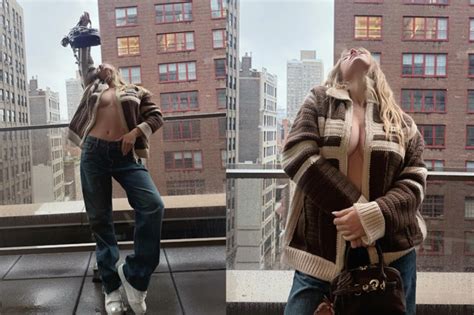
Melanie Collins, CBS NFL sideline reporter, ignited social media buzz during a recent broadcast, not just for her reporting, but for her fashion choice, with fans and viewers alike praising her “stunning” dress. The overwhelmingly positive reactions highlight the increasing attention paid to sideline reporters’ on-air style, demonstrating its impact on audience engagement.
Collins’s vibrant appearance quickly became a trending topic across various platforms, with users expressing admiration for her sophisticated and fashionable attire. The online commentary underscores the intersection of sports and fashion, where personal style choices can significantly influence public perception and media coverage. The episode reflects a broader trend of increased scrutiny and appreciation for the fashion sensibilities of on-air personalities, highlighting how style can play a crucial role in shaping a reporter’s brand and audience appeal.
The attention to Collins’ dress also sparks a discussion about the evolving role of women in sports broadcasting and the double standards they often face. While male commentators are rarely subjected to the same level of sartorial scrutiny, female reporters like Collins navigate a landscape where their appearance can both enhance and overshadow their professional contributions. This incident provides an opportunity to examine the biases and expectations that persist within the industry, prompting a critical analysis of the factors that influence public perception of female sports journalists.
During a broadcast, Melanie Collins wore a dress that caught the attention of viewers, and the internet quickly flooded with praise for the CBS sideline reporter’s look. Fans lauded her style, describing the dress as “stunning” and “beautiful,” prompting numerous social media posts and comments. This immediate and widespread reaction showcases how personal style can influence a reporter’s visibility and engagement with audiences, demonstrating the power of fashion in modern media.
The buzz surrounding Collins’ attire is part of a larger trend where the personal style of on-air personalities, particularly female sports reporters, gains significant attention. Social media has amplified this phenomenon, providing a platform for viewers to share opinions and engage in conversations about fashion choices. The focus on appearance raises broader questions about gender dynamics in sports broadcasting and the expectations placed on female reporters to maintain a polished and fashionable image.
The positive response to Collins’ dress can be seen as a testament to her fashion sense and an indicator of her ability to connect with viewers on multiple levels. Style choices can contribute to a reporter’s overall brand and influence how they are perceived by the audience. In a competitive media landscape, personal style can be a differentiating factor that helps reporters stand out and build a loyal following.
Collins’ dress became a trending topic because it resonated with viewers who appreciated its elegance and sophistication. Many fans expressed that her style enhanced her on-screen presence, adding a layer of visual appeal to her reporting. The widespread praise highlights the growing importance of fashion in media and the impact it can have on audience perception.
The discussion around Collins’ attire also touched on broader issues related to the portrayal of women in sports media. While some critics argue that focusing on appearance detracts from a reporter’s professional accomplishments, others contend that personal style is a form of self-expression and empowerment. The diverse range of opinions underscores the complexity of navigating gender expectations in a male-dominated industry.
The trending reaction to Melanie Collins’ sideline attire highlights how visual presentation has become intrinsically linked to media personalities’ roles, particularly in fields as visually consumed as sports broadcasting. Collins’ choice resonated strongly with audiences who are becoming increasingly perceptive about the aesthetic and styling of on-air reporters. The event underscores an industry-wide awareness that how media figures present themselves – their attire, grooming, and overall image – can significantly affect audience engagement and, by extension, their effectiveness as communicators.
The specific details of the “stunning” dress worn by Collins, as reported and parsed by social media commentators, often highlight aspects such as its cut, color palette, and overall elegance, which collectively contributed to the positive reception. Style experts and fashion bloggers frequently chime in to analyze and dissect such choices, further amplifying the buzz around these sartorial moments. The fact that such details are carefully scrutinized and readily disseminated demonstrates the heightened awareness and interest viewers have in the visual elements of sports broadcasting.
Fashion’s increasing relevance within sports broadcasting also has broader implications for the industry’s economic and marketing dimensions. Media outlets and broadcasting networks recognize the commercial potential in associating with personalities who are considered stylish and well-dressed, leading to collaborations with fashion brands, endorsements, and other promotional activities. For reporters like Collins, maintaining a fashionable on-screen presence can thus open up new avenues for professional advancement and revenue generation.
However, the focus on fashion and appearance is not without its critics. Detractors argue that undue attention to a reporter’s attire can overshadow their journalistic skills and professional expertise. Such criticisms raise important questions about gender biases and the double standards that female sports reporters often face, where their appearance is scrutinized far more intensely than that of their male counterparts.
Moreover, the pressure to maintain a consistently stylish appearance can also place a significant burden on reporters, requiring them to invest considerable time, effort, and resources into their wardrobe and grooming. This can create additional stress and challenges, especially for those who are already balancing the demands of a high-pressure profession.
For Melanie Collins, the positive reaction to her dress is a testament to her personal style and her ability to connect with viewers on multiple levels. By carefully curating her on-screen image, she has been able to enhance her brand and solidify her position as a respected and admired sports reporter. However, she and other female reporters must continue to navigate the complex terrain of gender expectations and professional standards, ensuring that their appearance complements rather than overshadows their journalistic contributions.
The rise of social media has only amplified the focus on sideline reporters’ fashion choices. Platforms such as Twitter, Instagram, and Facebook provide viewers with a direct line of communication to express their opinions and engage in conversations about everything from game analysis to personal style. This immediate feedback can be both a blessing and a curse for reporters, who must be prepared to handle both praise and criticism.
In addition to the attention from fans and viewers, sideline reporters’ fashion choices also draw interest from fashion bloggers and style critics. These experts often analyze and dissect reporters’ outfits, providing insights into the latest trends and offering advice on how to create a polished and professional look. This coverage further elevates the profile of sideline reporters and solidifies their status as fashion influencers.
The focus on fashion in sports broadcasting is not limited to female reporters. Male commentators and analysts are also subject to scrutiny, although perhaps to a lesser extent. The rise of stylish male athletes has influenced the fashion choices of male sports reporters, who are increasingly expected to dress in a modern and sophisticated manner.
As the line between sports and fashion continues to blur, sideline reporters will likely face even greater pressure to maintain a stylish and on-trend appearance. While this can be a challenging and demanding aspect of the job, it also presents an opportunity for reporters to express their individuality and connect with viewers on a deeper level.
The broader context of Melanie Collins’ trending dress incident extends into discussions about body image, self-expression, and the multifaceted roles media personalities occupy. As public figures, these individuals are seen not only as professionals but also as role models. How they navigate societal expectations regarding appearance can send powerful messages to their audience, especially young viewers who are developing their sense of self.
Collins, by embracing a style that resonated so positively, indirectly engages in this broader cultural dialogue. Her fashion choices become a form of communication, potentially influencing viewers’ perceptions of beauty standards, professional norms, and personal identity. The attention paid to her attire underscores how deeply intertwined personal expression and public persona have become in the digital age.
Moreover, Collins’ experience touches on the economic considerations of maintaining a public image. From designer clothing to professional styling services, the costs associated with presenting a consistently polished appearance can be substantial. These expenses are often necessary for individuals in high-profile positions, adding another layer of complexity to their professional lives. This reality highlights the financial pressures that media personalities face and raises questions about the accessibility of these careers to individuals from diverse socioeconomic backgrounds.
The scrutiny of Collins’ dress can also be viewed as a reflection of societal biases and expectations. While it is positive that her style was generally praised, the fact that her appearance became such a significant topic of discussion points to the pervasive focus on women’s looks in media. It is essential to critically examine these tendencies and challenge the notion that a woman’s worth is tied to her physical appearance. The incident provides an opportunity to advocate for a more equitable and balanced media landscape where women are judged primarily on their professional skills and contributions.
The intersection of sports, fashion, and media is a constantly evolving landscape. As social media continues to shape public discourse, the attention paid to sideline reporters’ fashion choices will likely remain a prominent feature of the industry. It is crucial for reporters to navigate this terrain with awareness, authenticity, and a commitment to upholding professional standards. By doing so, they can leverage the power of personal style to enhance their brand while also promoting a more inclusive and equitable media environment.
The focus on Melanie Collins’ dress further extends into the broader conversation about how technology and social media have transformed the way we consume media. With the advent of digital platforms, viewers have become more active participants in shaping the narrative, providing immediate feedback and engaging in real-time discussions about everything from the content of the broadcast to the appearance of the on-air personalities.
This heightened level of engagement has both positive and negative implications for media professionals. On one hand, it provides an opportunity to connect with viewers on a more personal level, building a loyal following and gaining valuable insights into audience preferences. On the other hand, it also exposes media personalities to intense scrutiny and criticism, requiring them to develop a thick skin and a savvy approach to managing their online presence.
The viral reaction to Collins’ dress underscores the power of social media to amplify trends and shape public opinion. Within minutes of the broadcast, her attire became a trending topic, with thousands of users sharing their thoughts and opinions. This rapid dissemination of information highlights the need for media professionals to be mindful of the messages they are sending through their personal style and to be prepared to address any potential controversies that may arise.
The incident also raises questions about the role of media organizations in managing the appearance of their on-air talent. Should networks have guidelines regarding dress code and personal style? Or should reporters be given the freedom to express their individuality without fear of criticism? These are complex issues with no easy answers, and they require careful consideration of the balance between professional standards and personal expression.
Ultimately, the focus on Melanie Collins’ dress is a reminder that media is a visual medium, and that appearance plays a significant role in how messages are received. While it is important to avoid placing undue emphasis on looks, it is also essential to recognize that personal style can be a powerful tool for connecting with audiences and enhancing the overall viewing experience. By embracing their individuality and carefully curating their on-screen image, media professionals can leverage the power of fashion to build their brand and solidify their position in the industry.
The continuous dialogue surrounding on-air personalities’ fashion choices also prompts reflection on the evolving standards of professionalism in modern media. While traditionally, professionalism was defined primarily by journalistic integrity, objectivity, and accuracy, the rise of digital media and social networking has expanded the definition to include aspects of personal branding and public image.
Today’s media professionals are expected not only to be skilled reporters and communicators but also to be savvy self-promoters who can cultivate a strong online presence and engage with audiences in meaningful ways. This requires a delicate balance between maintaining professional boundaries and embracing the opportunities for personal expression that social media affords.
The attention to Melanie Collins’ dress highlights the tension between these competing demands. On one hand, her attire was praised for its elegance and sophistication, suggesting that she successfully conveyed a polished and professional image. On the other hand, the intense focus on her appearance raised concerns about whether her journalistic skills were being overshadowed by superficial considerations.
The incident underscores the importance of media organizations providing support and guidance to their on-air talent as they navigate these complex issues. Networks should offer training on personal branding, social media management, and ethical considerations, empowering reporters to make informed decisions about how they present themselves to the public.
Additionally, media organizations should strive to create a culture that values diversity and inclusivity, recognizing that there is no one-size-fits-all approach to professionalism. By embracing a range of styles and perspectives, networks can better reflect the diversity of their audiences and foster a more engaging and authentic viewing experience.
Ultimately, the focus on Melanie Collins’ dress serves as a reminder that professionalism in modern media is a multifaceted concept that encompasses not only journalistic skills but also personal branding, public image, and ethical considerations. By embracing a holistic approach to professionalism, media organizations can empower their on-air talent to thrive in a rapidly evolving industry while also upholding the highest standards of journalistic integrity.
The social commentary surrounding Melanie Collins’ sideline style brings to light an ongoing debate about the commodification of media figures, particularly women. In an era where personal brand is paramount, individuals in the public eye are increasingly evaluated, and sometimes exploited, for their marketability. This commodification extends beyond talent and skill, often placing undue emphasis on appearance and superficial attributes.
Collins’ experience can be contextualized within a broader trend of objectification, where women’s bodies and fashion choices become subjects of public consumption and judgment. This dynamic raises ethical questions about the responsibilities of media organizations and the potential for exploitation of their on-air talent. It underscores the need for a more nuanced approach to how we perceive and discuss the appearance of media figures, recognizing that their worth extends far beyond their aesthetic appeal.
Furthermore, the commodification of media personalities can have detrimental effects on their mental health and well-being. The constant pressure to maintain a flawless image and the relentless scrutiny from social media can lead to anxiety, body image issues, and a sense of alienation. It is crucial for media organizations to provide adequate support and resources to help their on-air talent navigate these challenges and maintain a healthy work-life balance.
In addition to the individual impact, the commodification of media figures can also perpetuate harmful stereotypes and reinforce unrealistic beauty standards. By constantly showcasing individuals who conform to narrow ideals of beauty, the media can contribute to a culture of self-doubt and insecurity among viewers. It is important for media organizations to be mindful of the messages they are sending and to actively promote diversity and inclusivity in their programming and casting choices.
The focus on Melanie Collins’ dress, therefore, serves as a reminder that we must approach the discussion of media figures’ appearance with sensitivity and awareness. While it is natural to admire and appreciate someone’s style, it is crucial to avoid reducing them to their physical attributes and to recognize their inherent worth as individuals. By fostering a more respectful and equitable media environment, we can empower media figures to thrive while also promoting a more positive and inclusive culture for all.
Frequently Asked Questions (FAQ):
1. What was the main reason Melanie Collins’ dress became a trending topic?
The primary reason Melanie Collins’ dress became a trending topic was the overwhelmingly positive reaction from fans and viewers who praised her “stunning” and “beautiful” fashion choice during an NFL broadcast. This sparked widespread social media buzz and commentary, highlighting the growing intersection of sports and fashion.
2. How does the attention on Melanie Collins’ dress reflect on the role of women in sports broadcasting?
The attention reflects the complex and often unfair double standards that female sports reporters face. While their male counterparts are rarely scrutinized for their attire, female reporters’ appearances are often subject to intense public scrutiny. This incident highlights the need to challenge gender biases and focus on their professional skills and contributions.
3. What are some potential negative impacts of focusing heavily on a reporter’s appearance?
Focusing too much on a reporter’s appearance can overshadow their journalistic skills and expertise, potentially leading to a perception that their worth is tied to their looks. It can also create undue pressure to maintain a flawless image, leading to anxiety, body image issues, and financial strain related to wardrobe and styling expenses.
4. In what ways has social media influenced the attention given to sideline reporters’ fashion choices?
Social media has amplified the attention given to sideline reporters’ fashion choices by providing viewers with a direct platform to share their opinions and engage in real-time discussions about their outfits. This immediate feedback can be both positive and negative, creating a dynamic where reporters’ appearances become a constant subject of public commentary.
5. How can media organizations navigate the balance between professional standards and personal expression in regards to on-air talent’s style?
Media organizations can navigate this balance by providing support and guidance to their on-air talent through training on personal branding, social media management, and ethical considerations. They should also foster a culture that values diversity and inclusivity, recognizing that there is no one-size-fits-all approach to professionalism and encouraging reporters to express their individuality while upholding journalistic integrity.









